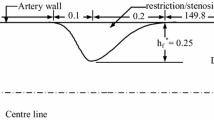Abstract
Atherosclerosis, which is a degenerative vascular disease, is believed to occur in the blood vessels due to deposition of cholesterol or low density hpoprotein (LDL) Atherosclerotic lumen narrowing causes reduction of blood flow due to hemodynamic features Several hypothetical theories related to the hemodynamic effects have been reported. high shear stress theory, low shear stress theory, high shear stress gradient theory, flow separation and turbulence theory, and high pressure theory However, no one theory clearly explains the causes of atherosclerosis The objective of the present study was to investigate the mechanism of the generation of atherosclerosis In the study, the database of Korean carotid and coronary arteries for geometrical and hemodynamic clinical data was established The atherosclerotic sites were predicted by the computer simulations. The results of the computer simulation were compared with the in vivo experimental results, and then the pathogenesis of atherosclerosis by using the clinical data and several hypothetical theories were investigated From the investigation, it was concluded carefully that the mechanism of the generation of atherosclerosis was related to the hemodynamic effects such as flow separation and oscillatory wall shear stress on the vessel walls
Similar content being viewed by others
Abbreviations
- A:
-
Coefficient of the diagonal term of the matrix
- C:
-
Convective contributions from the six surrounding control volumes
- SP:
-
Source term enhancing the diagonal dominance of the matrix
- p:
-
Pressure [Pa]
- q:
-
Index of Carreau model
- u:
-
Velocity [m/s]
- x:
-
Coordinate [m]
- ø :
-
Dependant variables
- γ :
-
Shear rate [l/s]
- ηoo :
-
Apparent viscosity at infinite-shear-rate [Pa.s]
- ηo :
-
Apparent viscosity at zero-shear-rate [Pa.s]
- λ :
-
Characteristic time [s]
- ρ :
-
Density [kg/m3]
- 1,J:
-
Tensor index
- nb:
-
Contributions of the neighbouring control volumes
- p:
-
Control volume whose variables
References
Caro, C G, Fitz-Gerald, J M and Schroter, R C, 1971, “Atheroma and Arterial Wall Shear Observation, Correlation and Proposal of a Shear Dependent Mass Transfer Mechanism for Atherogenesis,”Proc R. Soc. B, Vol 177, pp 109–159
Cho, M T, Roh, H W,Suh, S H and Kim, J S, 2002, “Pulsatile Flow Analysis of Newtoman Fluid in Circlular Tube,”KSME (B), Vol 26, No 1, pp 1585–1596
Fox, J A and Hugh, A E, 1966, “Localization of Atheroma a Theory Based on Boundary Layer Separation,”Bi Heart J, Vol 28, No 3, pp 388–399
Fry, D L, 1972, “Response of the Arterial Wall to Certain Physical Factors Atherogenesis Initiating Factors,” A Ciba Foundation Symp, ASP, Amsterdam, The Neterlands, pp 40–83
Lee, B K, Kwon, H M, Hong, B K, Park, B E, Suh, S H, Cho, M T, Lee, C S, Kim, M C, Kim, C J, Yoo, S S and Kim, H S, 2001, “Hemodynamic Effects on Atherosclerosis-Prone Coronary Artery wall Shear Stress/Rate Distribution and Impedance Phase Angle in Coronary and Aortic Circulation,”Yonser Med J, Vol 42, No 4, pp 375–383
Suh, S H, Roh, H W and Kim, J S, 2003, “Effect of the Velocity Waveform of the Physisologycal Flow on Hemodynamics in the Bufurcated Tube,”KSME International Journal, Vol 17, No 2, pp 296–309
Suh, S H, Roh, H W, Yoo, S S and Kwon, H M, 1996, “Numencal Simulation of Blood Flow in the Human Left Coronary Aitery,”The 9th Int Symp on Trans Phenomena in the Thermal-Fluids Eng, pp 91-96
Texon, M, Impaiato, A M and Helpern, M., 1965, “Role of Vascular Dynamics in the Development of Atherosclerosis,”JAMA, Vol 194, pp 168–172
Tucker, C and Myion, I C, 2001, “NF-kB Pivotal Medrator or Innocent Bystander in Atherogenesis?”J Clin Invest, Vol 107, No 3, pp 255–264
Author information
Authors and Affiliations
Corresponding author
Rights and permissions
About this article
Cite this article
Suh, SH., Roh, HW., Kim, DJ. et al. Significance of hemodynamic effects on the generation of atherosclerosis. J Mech Sci Technol 19, 836–845 (2005). https://doi.org/10.1007/BF02916132
Received:
Revised:
Issue Date:
DOI: https://doi.org/10.1007/BF02916132




